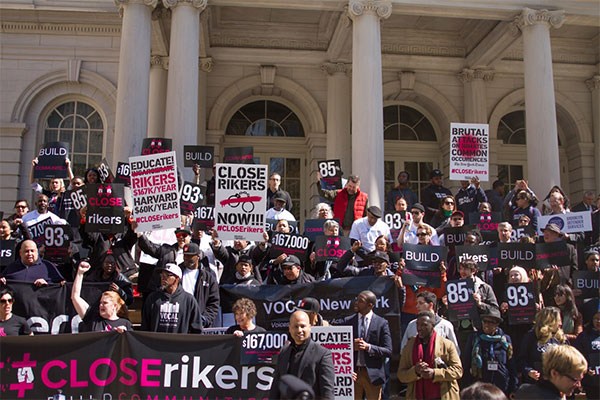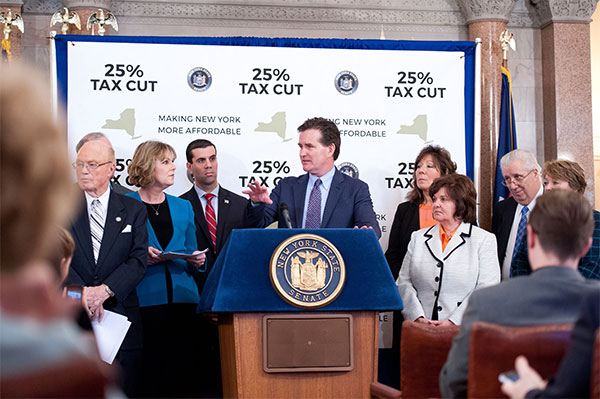Why We’re Marching to Close Rikers

Glenn Martin & others rally to #CLOSErikers (via JustLeadershipUSA)
For years, New Yorkers have been barraged by stories of violence and corruption on Rikers Island. On Saturday, September 24, hundreds of New Yorkers -- including people who have spent time on Rikers Island and their families; criminal justice reform activists; faith leaders; and elected officials -- will march together and demand that Mayor de Blasio #CLOSErikers.
Led by JustLeadershipUSA, in partnership with the Katal Center for Health, Equity, and Justice, the growing campaign has been endorsed by nearly 100 organizations representing a broad swath of New Yorkers. Saturday’s march and rally mark a turning point in the effort to shut down what City Comptroller Scott Stringer has called “an urban shame.” This is a movement with momentum that cannot be ignored.
By now, the reasons to shutter this jail once and for all are painfully obvious. The “systematic culture of violence” identified by U.S. Attorney Preet Bharara in his scathing 2014 report continues unabated, contrary to the Mayor’s blandishments that conditions are improving.
On Aug. 28, the Daily News reported that its review of internal documents showed that Rikers Island higher-ups were routinely “purging” unfavorable violence statistics to create an “illusion of reform.” Every week the media reports new atrocities: rapes, beatings, knifings, suicides. This cannot go on. Rikers Island is a human grist mill and an ugly stain on our city’s reputation for being progressive and compassionate. Rikers cannot be fixed; violence and corruption are embedded in its DNA.
With all of these problems, who can oppose closing Rikers? Mayor de Blasio has contended that closing the facility is “unrealistic” and too costly. On Saturday speakers will point out that our current system is too costly: We are spending $208,500 a year to detain one person on Rikers Island. That is money that can be better spent on programs to help individuals and communities. Furthermore, 80 percent of the people detained on Rikers are pre-trial, and should be waiting at home until they have their day in court.
Equally essential to closing Rikers is our demand to build communities. For decades, Rikers Island has meant tremendous suffering to our city’s most vulnerable communities. Most detainees come from the city’s poorest neighborhoods and 89 percent are black or Latino. More than 40 percent of the detainees have a diagnosed mental illness. Many others suffer from drug addiction. Confinement at Rikers only exacerbates these conditions. Spending months and even years in detention before trial because of the inability to raise bail money leads to the further impoverishment of families, including children. Claiming that ending a human rights disaster in our midst is “unrealistic” dishonors this great city.
The only thing preventing us from figuring out how to do the right thing is a lack of political will. And the right thing includes investing in those neighborhoods that have been most seriously damaged.
There have been efforts to close Rikers in the past – once during the Koch administration in the late 1970s and again under Mayor Bloomberg. Both efforts suffered from a lack of community involvement and support. Today, the #CLOSErikers campaign is building momentum with community support from across our city.
For many of the people who are part of this campaign, who will be on the streets Saturday, this issue is deeply personal. We’ve both been directly affected by experiencing the terrors of Rikers -- Glenn spent time on Rikers twice during the 1990s; Anna’s son Jairo recently spent more than five years there waiting for trial. Most striking is that the horrors of Rikers Glenn experienced in the 1990s remain largely unchanged today.
We are marching because we have had enough of the human carnage and want to spare future generations of New Yorkers from it. It is time to close Rikers and build communities.
The march will begin in Astoria at Steinway Street and 30th Avenue at 1 p.m. on Saturday, September 24. New Yorkers will march to a rally at the foot of the Rikers Island bridge at 19th Avenue and Hazen Street, where we’ll call on Mayor de Blasio to take action and close Rikers. Speakers include Emily Althaus, actress in Orange Is The New Black, elected officials from the City Council and the state Legislature, and numerous community leaders who have been impacted by Rikers. Join us.
***
Glenn E. Martin is the Founder of JustLeadershipUSA (JLUSA), an organization dedicated to cutting the US correctional population in half by 2030, and a national criminal justice reform advocate who spent six years in New York prisons. On Twitter @glennEmartin.
Anna Pastoressa’s son Jairo spent nearly six years at Rikers awaiting trial, suffering physical and emotional torment. She endured the indignities of visitation and the outrageous delays in the criminal justice system and is now a prison reform advocate.
***
Have an op-ed idea or submission for Gotham Gazette? Email This email address is being protected from spambots. You need JavaScript enabled to view it.
Keeping a Republican State Senate Majority is Essential for New York

Senate Leader Flanagan & other GOP Senators (photo via NYS Senate)
Whether it’s at the state or federal level, recent history has demonstrated that when one party controls government, checks and balances go out the window. Recent history has some important lessons as we approach this year’s crucial elections.
In 2008 Democrats took control of Congress and along with the election of President Barack Obama, controlled the executive and legislative branches in Washington. In Albany, for the first time since 1964, Democrats gained a majority in the state Senate and along with Democrats in the Assembly and Governor’s office, controlled all of state government.
In Washington, Democrats enacted Obamacare and tax increases to pay for a health care program most people didn’t want. They ignored larger economic issues and failed to deliver on things Americans really wanted like jobs and tax relief. They rejected compromise and bipartisanship and governed largely on their own.
In New York, it was even worse. Democrats had a lock on state government and controlled the Legislature and every state-wide elected office. In the state Senate they set out on a path that rejected bipartisanship in favor of an agenda that left many without a voice, particularly upstate and in the suburbs.
Emboldened by their new majority status and dominated by New York City members, Senate Democrats had to prove they could govern and deliver results. And deliver they did. But in doing so they nearly bankrupted the state and made it more difficult for middle class families to make ends meet.
Without a single Republican vote, they enacted record spending hikes and some of the largest tax hikes in state history. New spending totaled $14 billion, matched by $14 billion in new taxes enacted. A new MTA tax on businesses was instituted and STAR rebate checks for homeowners were taken away. Limited state resources were shifted to New York City at the expense of upstate and the suburbs.
Democrats presided over a dysfunctional Senate where chaos ruled, culminating in an uprising led by renegade Democrats that produced an unprecedented disruption in state government and a constitutional crisis that forced the state’s highest court to step in and restore order.
New Yorkers clearly had enough. They took matters in hand and returned Republicans to the Senate majority in 2010.
Working with a new governor and more recently, new leadership in the Assembly, Senate Republicans got things back on track. They turned a $10 billion deficit into a surplus. They delivered six on-time budgets, enacted a property tax cap and new rebates for homeowners. They produced record increases in aid to education and delivered the largest tax cuts in state history.
They also undid much of the damage. New payroll taxes on businesses were repealed, property tax rebate checks were returned, and damaging cuts in education aid that forced schools to needlessly suffer were restored.
But some of the damage could not be undone. The disruption and divisions within the Senate Democrat Conference were beyond repair. Many senators grew frustrated with the dysfunction and misguided policies as their moderate views no longer fit in. They didn’t feel welcome.
So they did something about it. A number broke away and formed a separate Independent Democratic Conference, the IDC. Another decided to sit with Republicans and join their conference. All were determined to restore bipartisanship in the Senate. Together they forged a working partnership with Majority Republicans that continues to this day.
But some divides remain. None more so than the upstate-downstate divide, which continues to challenge lawmakers. Democrats, with their majorities overwhelmingly from New York City, see urban policies that favor New York and other large cities as their primary focus. Republicans fight to ensure that upstate and suburban areas get their fair share.
It is a constant battle. And without a seat at the table, upstaters and suburbanites get left out and suffer the consequences. We’ve seen it happen.
That’s why maintaining a Republican Majority in the Senate is critically important. Their members are from upstate and downstate; from suburban, rural, and urban communities. They give voice to small businesses and middle class New Yorkers and serve as their protectors in a government dominated by New York City interests.
Having spent nearly 30 years in the Senate, I witnessed it all. I watched Republicans serve as a responsible check on Assembly Democrats and governors from both parties. I saw them stop tax increases and government overreach because they were the lone voice of reason. And I was there when battles were lost and compromise was necessary to keep government functioning.
In my last two years, with New York City Democrats in charge, I also saw Republicans entirely shut out of the governing process. I witnessed the dysfunction and chaos that ensued and policies that nearly bankrupted and ruined our state. It was enough to convince voters that they had to change course.
In November voters will be faced with a similar choice. They can maintain the checks and balance so vital in our democracy or they can give Democrats sole control of state government and enable a New York City Mayor like Bill de Blasio to expand his reach on Long Island, the Hudson Valley, and even upstate.
Now that we’ve come this far, New Yorkers don’t want a return to the past. They want a healthy two-party system and assurances that all regions are treated fairly and equally. That’s why Senate Republicans should, and I believe will, be returned to the Senate Majority. Republicans offer the best hope to those who want checks and balances in government and the accountability that comes with it.
***
John McArdle is President of Capitol Communications, a government consulting and communications firm. He worked in the State Senate from 1981 to 2010 and was Communications Director for three Majority Leaders.
***
Have an op-ed idea or submission for Gotham Gazette? Email This email address is being protected from spambots. You need JavaScript enabled to view it.
In the Face of Bigotry, Teachable Moments

(photo via @NYCSchools)
This school year is very different from previous years. This September, students began their classes in the midst of a heated presidential race and a hostile political climate where nearly every young New Yorker -- black, Latino, immigrant, LGBTQ, female, and Muslim -- has been maligned by politicized messages of racism, sexism, xenophobia, homophobia, and bigotry.
This year, however, could also be different in other ways. If parents, teachers, and community leaders step up to the plate, this could be a year where we take time to educate our children about our nation’s First Amendment.
This nation was founded on the premise that all people should have freedom of religion; it is part of what makes our country extraordinary. No one should live in fear because of the color of their skin, the language they speak, or how they pray. This year is the perfect time to educate our children about what it really means to stand as one nation, undivided, no matter our faith traditions or our country of origin.
Students who are Muslim or perceived to be Muslim are under particular attack this year. Within a four-week range, there have been three murders of Muslims in New York, the city I call home. In Brooklyn last week, two women were assaulted while pushing their children in strollers for no reason other than they dared to leave their homes wearing headscarves. A Muslim woman in hijab window shopping in midtown Manhattan was set on fire. One can’t help but wonder how many other incidents of harassment and abuse go unreported in communities across the city and country.
Obviously, this is not a local problem. On a national level, anti-Muslim rhetoric has increased exponentially during the current presidential race. Our nation’s children have seen, again and again, proposals to ban all Muslims from entering the United States, to launch a database specific to Muslims, or even reintroduce internment camps.
In a school system of 1.1 million students, I can’t imagine what it is like for Muslim students and those perceived to be Muslim in New York City, especially during this time. Sadly, students experience prejudice and discrimination from their peers. In the days after Donald Trump’s initial call for a ‘Muslim ban’ back in the Spring, 10-year-old Nadine’s mother called me that her daughter was bullied in school and asked what should she do about it. Nadine, who lives and goes to school in the Bronx, was told by one of her peers that all Muslims are terrorists and ISIS and Muslims should go back to their country. Nadine’s heart sank and she felt defenseless in front of peers who said nothing to her aggressor, her mother told me.
Nadine is not alone, there are children across the US who are being bullied based on their religion. Bayan Zehlif, a Muslim student and senior in Rancho Cucamonga, CA was misidentified as “ISIS Philips” in her high school yearbook photo. What a terrible way to end your high school career.
Incidents like these can be prevented if schools make a concerted effort to create a caring and nurturing environment in every classroom where every child sees a reflection of him/herself in their peers. While we teach Common Core standards, prepare for AP tests, and coach our students before the SATs, we must not forget to prioritize students’ civic education. Their understanding of the world around them must include a focus on the virtues of a pluralistic society and empathy for their fellow human beings.
Empathy and respect for plurality can be fostered from simple “getting to know each other” activities, sharing stories of culture, costumes, and traditions, and discussions of what holidays stand for. Even hosting an open conversation about what it is like to be different from each other, and how that makes our democracy stronger, can shift the perspectives of our students to a more productive place.
When we invest in the time to do this, we connect our students, by mind and heart. We build bonds between them to see each other as allies and fellow students, not adversaries. As a result, we empower students to be upstanders, not bystanders, when one of their peers comes under attack. After all, this is what we want our country to look like. It should start in the classroom.
***
Dr. Debbie Almontaser is the founding and former principal of the Khalil Gibran International Academy. On Twitter @DebbiAlmontaser.
***
Have an op-ed idea or submission for Gotham Gazette? Email This email address is being protected from spambots. You need JavaScript enabled to view it.




